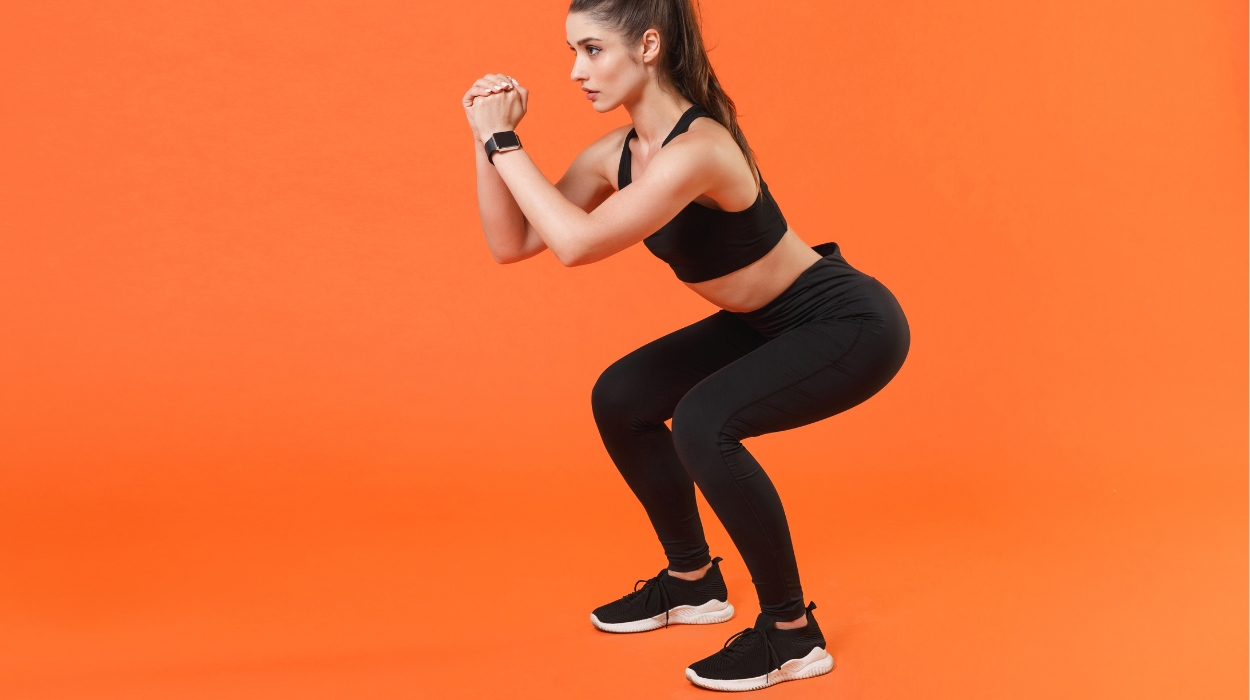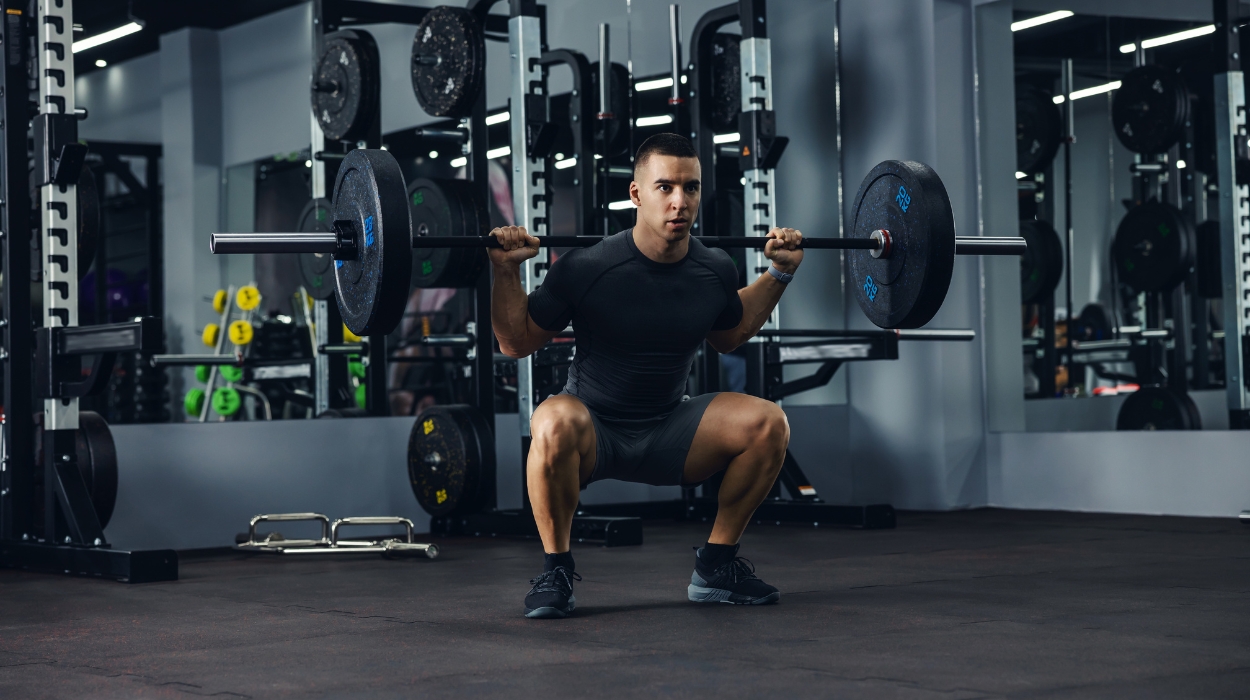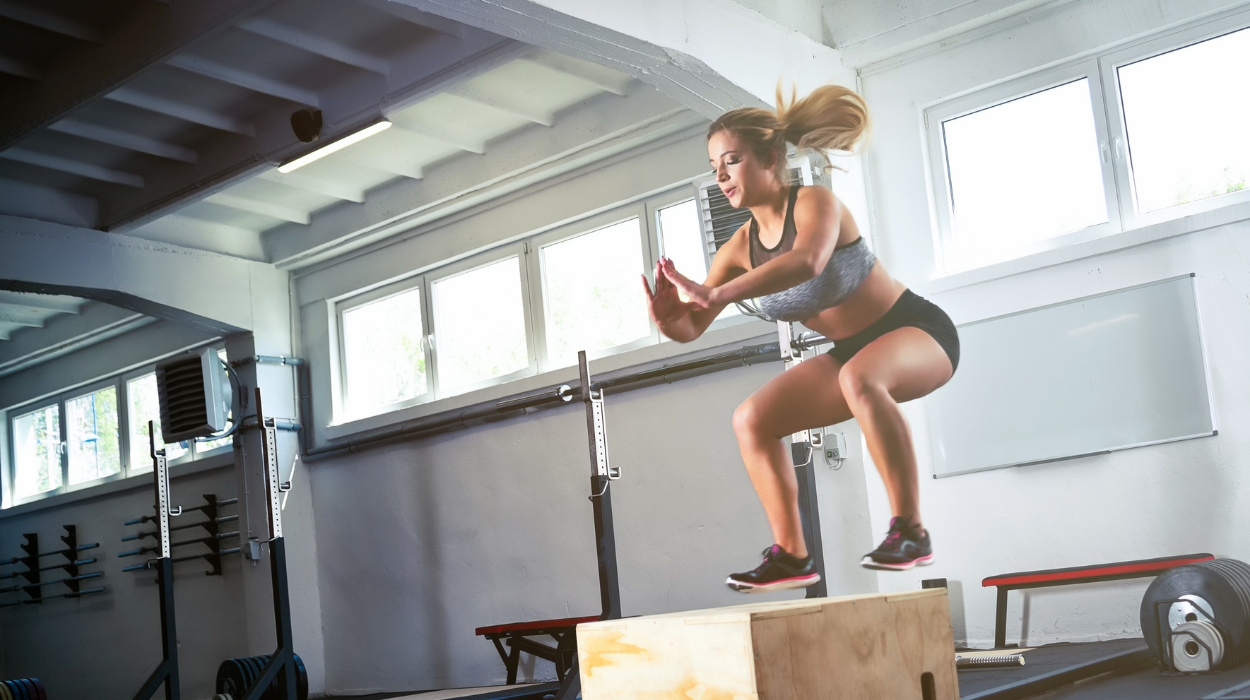 Expert's opinion
Expert's opinion
Expert's opinion
The article is a subjective view on this topic written by writers specializing in medical writing.
It may reflect on a personal journey surrounding struggles with an illness or medical condition, involve product comparisons, diet considerations, or other health-related opinions.
Although the view is entirely that of the writer, it is based on academic experiences and scientific research they have conducted; it is fact-checked by a team of degreed medical experts, and validated by sources attached to the article.
The numbers in parenthesis (1,2,3) will take you to clickable links to related scientific papers.
Do Squats Help You Lose Weight? Best Squat Exercises 2024

Are you looking for an effective way to shed unwanted pounds? Then you need to include squats in your workout routine.
Squats are a favorite exercise among athletes and fitness experts alike because they do so much to benefit your health. Squats build strength, burn calories, and improve overall physical fitness by engaging multiple muscle groups.
Best of all, it’s easy to learn how to do them right so you can start immediately.
Let’s take a look at why squats make you lose weight and how you can incorporate this powerful exercise into your routine.
Can Squats Help You Lose Weight?
Squat exercises are an incredibly efficient way to burn calories, making it easier to achieve the calorie deficit needed for weight loss. In fact, completing continuous half-squat[1] exercises can burn more calories per minute than running on a treadmill.
Plus, strength-building exercises like squats influence your metabolism and hormones in ways that aid in fat loss.
These facts do not mean you should stop your cardio routine and focus only on strength-building exercises. Cardiovascular exercise has numerous health benefits and is a great way to burn calories.
Do Squats Help You Lose Weight?
First and foremost, it’s essential to understand that one exercise alone will not produce any significant weight loss. To lose weight, you must maintain a calorie deficit by burning more calories than you eat over time.
The best way to achieve a consistent calorie deficit is through a combination of physical activity and dietary changes.
So how does squatting help you lose weight?
Squat exercises are an incredibly efficient way to burn calories, making it easier to achieve the calorie deficit needed for weight loss. In fact, completing continuous half-squat[1] exercises can burn more calories per minute than running on a treadmill.
Plus, strength-building exercises like squats influence your metabolism and hormones in ways that aid in fat loss.
These facts do not mean you should stop your cardio routine and focus only on strength-building exercises. Cardiovascular exercise has numerous health benefits and is a great way to burn calories.
However, balancing your cardio with strengthening exercises like squats can help you take your progress to the next level.
As a rule of thumb, the Centers for Disease Control and Prevention recommend[2] aiming for 150 minutes of moderate-intensity cardiovascular activity per week paired with at least two days of strength-building exercises.
Here’s why squats should be your go-to exercise for building strength and promoting weight loss.
Benefits Of Squats For Weight Loss
Squats are particularly beneficial for weight loss because they:
- Build muscle.
- Burn calories.
- Produce fat-burning hormones.
- Improve body composition.
- Improve overall fitness.
Squats Build Muscle
Squats challenge the large muscles in your lower body and promote muscle growth in these areas.
Building more muscle helps with weight loss because muscle is a metabolically active tissue. As such, muscle tissues burn energy in the form of calories to function properly.
Therefore, when you increase the amount of active muscle in your body, you boost the number of calories your body burns throughout the day.
While the exact amount of extra calories burned daily by packing on more muscle is controversial, the fact remains that increasing calorie burn throughout the day can only help with your weight loss journey.
Squats Burn Calories
Squats are a compound lower-body exercise, which means they engage multiple muscle groups in one maneuver. As you work more muscles, you burn more calories to fuel and repair them.
Below are all of the muscle groups that are activated when you do basic full squats:
- Quadriceps — front of thighs.
- Hamstrings — back of thighs.
- Glutes —backside.
- Abdominals —core muscles.
- Calves.
Different types of squats may activate additional muscles, including upper body muscles and back muscles.
According to a study[1] comparing the calorie-burn effects of a variety of common exercises, half-squats burned more calories per minute than any other exercise. An intense bout of half-squats burned up to 35 calories per minute in study subjects who weighed 173 pounds, on average.
Comparing this to running on a treadmill, which would burn about nine calories per minute in a similar weight person, you can see how including squats in your fitness plan can boost calorie burn and help with weight loss.
Squats Increase Fat-burning Hormone Production
After a tough squat workout; your body produces[3] anabolic hormones that can help with weight and fat loss. These hormones include testosterone, human growth hormone, and insulin-like growth factor.
The purpose of releasing these hormones is to stimulate muscle repair and growth. As discussed, this is good news for reducing weight because the more muscle you have, the more calories your body burns each day.
However, that’s not all these hormones do. According to at least one study[4], the hormone testosterone can increase body fat loss while dieting. Plus, research[5] has linked low levels of these hormones with weight gain later in life.
If you’re hoping that this means squats are the secret to six-pack abs, hold that thought. These observations don’t mean that squats help you lose belly fat specifically. It’s not possible to target fat loss in only one area of your body.
But, if you stick with a strength-building routine, you will see positive changes to your entire body with time.
Squats Improve Body Composition
Your body composition describes the percent of fat, bone, water, and muscle that comprise your total body weight.
Changes to any of these components will result in weight loss, highlighting the difference between weight loss and fat loss. You can lose weight by sweating on a hot day, but this does not change the shape of your body.
What most people want to achieve when they set out to lose weight is the lean figure that comes with body fat loss.
If you’re only doing cardio workouts, you’re probably losing equal amounts of muscle and fat. As a result, you may end up smaller but not leaner.
Plus, when you lose muscle mass you lower your metabolic rate. The fewer calories you burn daily, the harder it is to maintain a healthy weight.
Strength-building exercises paired with cardio help preserve muscle mass and burn fat while losing weight leading to better overall body composition.
Squats Improve Overall Fitness
Normal daily activities, like carrying groceries or playing with your kids, significantly contribute to the calories your body burns throughout the day.
The calories burned from these activities are called Non-Exercise Activity Thermogenesis[6].
By improving your overall fitness, squats help boost NEAT levels and enhance weight loss success.
Because squats build more muscle mass, strength, flexibility, and mobility, you may find it easier to take the stairs, clean the house, or even walk to work. These small increases in daily activity have a big impact on your weight goals.
How To Lose Weight With Squats
Ready to incorporate squats into your workout routine to help you reach your goal weight?
One of the best things about squat exercises is that you can do them anywhere. All you need is your body to start making progress.
While there are many variations of squats, the half squat is a great place to start for almost everyone. Half-squats reduce the risk of a knee injury while engaging the same muscle groups. The half squat can also improve[7] mobility.
It’s crucial, however, that you start by practicing good form. Here’s your step-by-step guide for completing basic bodyweight half squats:
- Stand with your feet shoulder-width apart.
- Keep your back straight, your shoulders back, and your arms relaxed down by your sides.
- Push your hips back so you are resting on your heels. Bend your knees and lower your body as if you are going to sit down in a chair.
- As you descend, ensure your knees stay directly over your ankles and your shins maintain a vertical line. You also want to make sure that your knees are pointing forward, maintaining the space between them and not turning in towards each other.
- Stop when your thighs are parallel to the floor. Push up on your heels to return to your standing position.
Best Squat Workouts For Weight Loss
After you’ve mastered your form with bodyweight half squats, pick two non-consecutive days during the week to complete your squat exercises.
Start each squat workout with a 10-minute warm-up, like brisk walking or jumping jacks. Follow this up with a five-minute stretch.
Once you’re warmed up, the squat workouts below will help you burn fat, increase strength, and reduce weight:
High Volume, Weighted Squat Workout

Performing a high volume of reps will maximize your calorie-burning potential.
- Aim to complete six sets of five squats using only the weight of your body.
- After the first week, add weight to your squats using dumbbells in each hand or a kettlebell held against your chest. Add enough weight so that your squats begin to feel challenging by the third set of each rep.
- Keep track of your progress and continue to add weight so your workouts stay challenging as you build strength. Be cautious not to add too much weight so that you can’t maintain proper form.
High-Intensity Interval Training With Squats

High-Intensity Interval Training is a type of workout that combines short bursts of intense exercise with periods of rest. HIIT workouts are known to burn a lot of calories in a short amount of time.
Here’s how you can complete a basic HIIT squat routine:
- Using a timer, squat as many times as possible within 30 seconds, then rest for 30 seconds. Repeat the cycle as many times as you can, but try to challenge yourself to complete at least ten cycles.
- Add weight to increase the challenge as your fitness level improves.
- Make sure you focus on proper form as you move swiftly through this workout. Prevent injury by taking a break if you’re too tired to maintain proper positioning as you squat.
Over time you may want to include different squat variations in your workouts to target specific muscle groups and keep things interesting. Jump squats, sumo squats[8], and squat pulses are a few of the best exercises for weight loss.
Can Squats Cause Harm?
In women, squats of any kind can increase the pressure that tends to push out the bladder or rectum — pelvic floor prolapse[9] — especially in postmenopausal women or those having had vaginal deliveries. This can cause incontinence but can be prevented by asking your provider to refer you to a pelvic floor physical therapist who can coach you on how to avoid these pressures while exercising.
In men and women, squats — especially with weights — can put undue pressure on your vertebral disks[10]. This can be prevented by consulting with a back specialist before beginning such an exercise regimen.
The Bottom Line
Incorporating squats into your exercise routine has many benefits. Squats can help you reach a healthy weight by burning calories and promoting fat loss. Squats also help increase your muscle mass and make you stronger.
Slow and steady wins the race when it comes to squats. Practice proper form before increasing your intensity to avoid injury; men and women should consult with the right specialist to avoid injury to the pelvic floor and intervertebral disks.
Aim to include squats in your workout routine at least twice a week. You’ll quickly see the positive effects of squats throughout your whole body!
+ 10 sources
Health Canal avoids using tertiary references. We have strict sourcing guidelines and rely on peer-reviewed studies, academic researches from medical associations and institutions. To ensure the accuracy of articles in Health Canal, you can read more about the editorial process here
- Reis, V.M., Garrido, N.D., Vianna, J., Sousa, A.C., Alves, J.V. and Marques, M.C. (2017). Energy cost of isolated resistance exercises across low- to high-intensities. PLOS ONE, [online] 12(7), p.e0181311. doi:10.1371/journal.pone.0181311.
- CDC (2022). How much physical activity do adults need? [online] Centers for Disease Control and Prevention. Available at: https://www.cdc.gov/physicalactivity/basics/adults/index.htm#:~:text=Each%20week%20adults%20need%20150,Physical%20Activity%20Guidelines%20for%20Americans.
- Wilk (2018). Endocrine response to high-intensity barbell squats performed with constant movement tempo and variable training volume. Neuro endocrinology letters, [online] 39(4). Available at: https://pubmed.ncbi.nlm.nih.gov/30531700/
- Ng Tang Fui, M., Prendergast, L.A., Dupuis, P., Raval, M., Strauss, B.J., Zajac, J.D. and Grossmann, M. (2016). Effects of testosterone treatment on body fat and lean mass in obese men on a hypocaloric diet: a randomised controlled trial. BMC Medicine, [online] 14(1). doi:10.1186/s12916-016-0700-9.
- Kelly, D.M. and Jones, T.H. (2015). Testosterone and obesity. Obesity Reviews, [online] 16(7), pp.581–606. doi:10.1111/obr.12282.
- Levine, J.A. (2002). Non-exercise activity thermogenesis (NEAT). Best Practice & Research Clinical Endocrinology & Metabolism, [online] 16(4), pp.679–702. doi:10.1053/beem.2002.0227.
- Loturco, I., Pereira, L.A., Moraes, J.E., Kitamura, K., Cal Abad, C.C., Kobal, R. and Nakamura, F.Y. (2017). Jump-Squat and Half-Squat Exercises: Selective Influences on Speed-Power Performance of Elite Rugby Sevens Players. PLOS ONE, [online] 12(1), p.e0170627. doi:10.1371/journal.pone.0170627.
- Coratella, G., Tornatore, G., Caccavale, F., Longo, S., Esposito, F. and Cè, E. (2021). The Activation of Gluteal, Thigh, and Lower Back Muscles in Different Squat Variations Performed by Competitive Bodybuilders: Implications for Resistance Training. International Journal of Environmental Research and Public Health, [online] 18(2), p.772. doi:10.3390/ijerph18020772.
- Womenshealth.gov. (2013). Pelvic organ prolapse | Office on Women’s Health. [online] Available at: https://www.womenshealth.gov/a-z-topics/pelvic-organ-prolapse
- Yanagisawa, O., Oshikawa, T., Adachi, G., Matsunaga, N. and Kaneoka, K. (2020). Acute effects of varying squat depths on lumbar intervertebral disks during high‐load barbell back squat exercise. Scandinavian Journal of Medicine & Science in Sports, [online] 31(2), pp.350–357. doi:10.1111/sms.13850.



